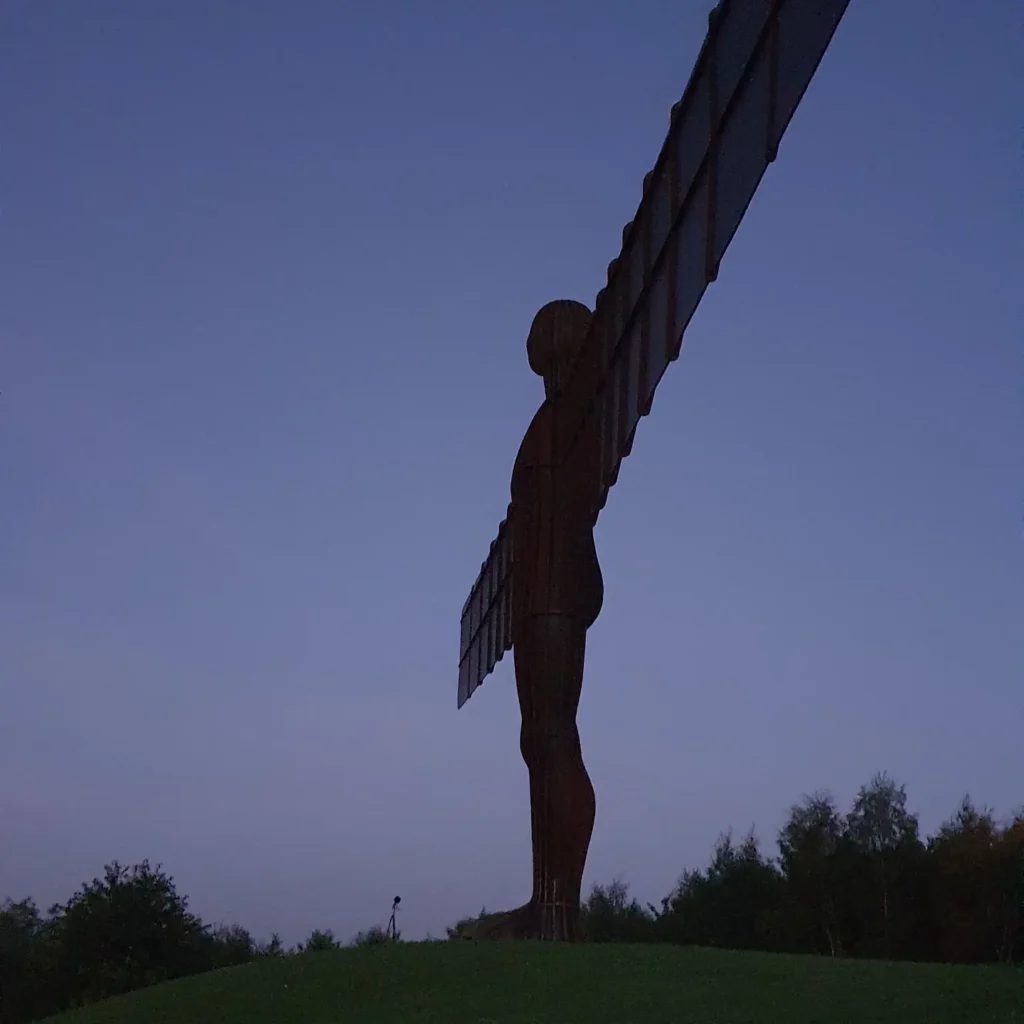
If you walk into Leeds City Art Gallery, a life-size brick sculpture of a man stands directly in front of you. This is the maquette for The Brick Man, a monumental sculpture by Antony Gormley that was never realised but that is now widely seen as an important precursor for The Angel of the North. Gormley proposed the sculpture in 1988 for the Holbeck area of Leeds, where it would have stood over 30 metres high on land surrounded by railway lines, and greeted travellers arriving at Leeds station. (The Angel now stands 20 metres high, surrounded by roads and welcoming drivers into Gateshead.) The brick construction of the proposed sculpture referenced the brickworks that had formerly occupied the Holbeck site, which was derelict wasteland by 1988. The Brick Man would thereby have materialised the industrial heritage of the area of Leeds for which it was designed, a full decade before The Angel commemorated the colliery that occupied the Gateshead site on which it now stands.
If you walk round the maquette of The Brick Man to look at the back, a small doorway is visible in one of its heels. Here, visitors would have entered to gaze up at the hollow interior of the sculpture and take in its height and scale. Once inside the structure, visitors would have had the opportunity to climb a staircase, which led up to windows in the man’s ears; from here, visitors could take in the view of the city that the high vantage point afforded. Gormley abandoned this access to the sculpture’s interior for his design of The Angel a decade later; it is nevertheless a helpful reminder of how important the hollow interior of his sculptures was for Gormley at this time.
Gormley’s extensive study of Buddhism and meditation had given him a long-standing interest in the human body as it is experienced from the inside. His sculptural figures are typically moulds of the human form, which often use his own body as the model. The sculptures as moulds or ‘body cases’ have an empty space within, which Gormley has linked to the meditation that he practices while the mould is being made. He describes the experience of being encased in plaster in this way:
In the moulding process I have to be very still and to be breathing regularly. I have to try not to think about the outside and to be completely concentrated on the space that exists behind appearance. At first this experience is very claustrophobic. . . . As the plaster goes on and I am enclosed ever more deeply in a damp, dark, soft enclosure, there is a descent into the darkness of the body. This is the space that we all spend our lives escaping from, but it is also the place of imagination: a place that starts with feelings of claustrophobia but opens into an extension as wide as a sky at night. (‘Feeling into Form’, p. 1518)
Gormley’s sculptures arise out of meditation and invite their viewers to use the work as a means for their own reflection. In The Brick Man, the proposed encounter with the interior ‘darkness of the body’ was literal, with the visitor entering the sculpture’s internal space. Although The Angel can only be viewed externally, it works on the same principles as Gormley’s other work of this period, its stance and hollow interior asking the viewer to participate in the meditative state that is, for the artist, the origin of all his work.
The location of the sculpture also contributes to the meditative feeling that Gormley seeks to evoke. The Brick Man and The Angel were both designed to represent still centres in environments where people routinely rush past, whether by rail or by car. Gormley has written of the placing of his works:
I guess we then have to ask how these works fit into the world and how they can evoke or identify a feeling in space, how in a time of extreme visual cacophony in the built environment do we use the space of sculpture to reinforce the self in this confused and commercialized world? As we walk down the street, our attention is constantly bombarded with bright new goods in the shop windows, a man trying to evangelize with a microphone in the centre of the street, brief glimpses of the weather, a cloudless sky, an impending storm, large advertisements, the ringing and talking in mobile phones. In this distracting and distracted world, so lacking in cohesion, how do we insert sculpture as both a point of symbolized self in the world and a place for self in the world, a place that is silent, still, removed? (‘Feeling into Form’, pp. 1513-14)
Gormley thinks of sculpture as something that is not only itself still and unmoving, but that can be deliberately placed in a hectic urban environment to create a space of stillness and reflection for its visitors. Although his example is a high street, it readily transfers to the busy roads that surround The Angel. Those who are driving past on the A1 can pause their journey to find a place that feels ‘still’ and ‘removed’. It is instructive, too, to think about the language that Gormley uses here – even as he thinks about the visual, he turns to the auditory to make his point, speaking about ‘cacophony’, the man with the microphone, and the constant background chatter of the mobile phone. The feeling that sculpture evokes not only stills movement; it also quietens noise.
When I was standing at the feet of The Angel this morning, there was a loud thump above me, followed by a reverberation down the body of The Angel that passed through the ground to me, rising through my feet and up my body. My first thought was that a bird had flown into one of The Angel’s wings and that the sound was caused by the impact, but I could see no sign of any collision. I concluded that the warm sun heating the metal after the recent freezing temperatures had caused it to expand, producing the booming noise that I both heard and felt. This encounter with The Angel’s sound acted as a forceful reminder of its hollow interior, which shaped the deep reverberation that resonated through my own body.
The incident caused me to reflect on what it means to sound The Angel in our project. It reminded me to be wary of any claim that David and I are uniquely able to reveal The Angel’s sound through technology, when a combination of atmospheric conditions and sculptural form had produced such a deeply resonant noise. It also cautioned me against using language such as ‘the voice’ of The Angel, because we are neither making The Angel speak, nor adding its noise to the nearby cacophony of traffic. What we are capturing instead is the echo of The Angel’s surroundings as they reverberate through its hollow structure – whether that is the sound of the traffic, of wind, or of rain. This takes us closer to Gormley’s own interest in the interior of his sculptures as a space of encounter and imagination. I am reminded of the visitors who recently listened through David’s headphones to The Angel’s resonances and observed that the noise sounded like something you could either meditate to, or compose with. The sounds that David is recording retain the sense of stillness that Gormley associates with sculptural form, giving us an entry point into imagining the interior of The Angel, the hollow space that was so central to Gormley’s artwork of this period. Instead of walking into the structure and peering up into its shadowy interior, sound can evoke its elusive inner form for us through echo and vibration.
In the placing of The Brick Man and The Angel, the historical resonance of the site was key, informing both the form and the material of the sculpture. Situated on abandoned post-industrial wasteland, sculpture aimed to reclaim it as a place – an artistic practice that was tied to policies of urban regeneration, but also extended beyond this to create a site of pause and reflection. Speaking about the relation between art and spirituality at Durham Cathedral in 1996, Gormley reflected on the spiritual role of sculpture in a secular society, observing:
I am interested in reviving [the] idea of presence. Can we have presence without the God? Can we resurrect the monument without bringing the shadow of bad history? The idea of an image that is open enough to be interpreted widely, that has multiple and generative potential for meaning but is strong enough to be a focus. How can we construct such an image? In being someone’s can it be everyone’s? (‘Art and Spirituality’, p. 156)
The Angel manifests as one potential solution to Gormley’s questions: a symbol that is open to interpretation, and a powerful focal point; an image that references religion, but holds a broad spiritual resonance. The grassroots memorial that has emerged at the site suggests that The Angel has taken on the kind of ‘presence’ that Gormley was interested in, becoming a place of spiritual significance in a predominantly secular time.
Gormley’s statement about the Angel that has been placed on site refers to the mound on which the sculpture stands as a significant factor in its effect. He says: ‘The hilltop site is important and has the feeling of being a megalithic mound’. In addition to the historical resonance of the mine beneath, the positioning of the sculpture on the raised ground evokes a sense of neolithic monuments. Driving past The Angel and viewing it from the A1 has something of the effect of seeing Stonehenge rising in the distance across Salisbury Plain. The approach to The Angel on foot entails walking up the mound towards it, and then standing beneath its towering form. Visitors often reach out to touch The Angel as they would the stone of a megalith. I have written in previous posts about the trees of the memorial feeling like an ancient grove, and the tying of ribbons to the trees resembling Celtic traditions and beliefs. There is, then, a discernible continuity between the ancient spiritual resonances that Gormley evoked in his design of The Angel and the grassroots memorial practices that have more recently emerged at the site.
References
Antony Gormley, ‘Art and Spirituality’, Address at a conference in Durham Cathedral, October 1996. Reproduced in John Hutchinson, E. H. Gombrich, Lela B. Njatin and W. J. T. Mitchell, Antony Gormley (London and New York: Phaidon, 2000), pp. 154-56.
Antony Gormley, ‘Feeling into form’, Philosophical Transactions of the Royal Society B, 362.2132 (2007), pp. 1513-18.

